Developing Marketing Strategies Through the OKR Method Around the Marketing Funnel + Template
It is a great importance to create an activity plan in line with our own goals and strategies in addition to carrying out our marketing activities with the needs and expectations of our target audience in mind. At this point, the marketing funnel is really helpful. In fact, I think developing strategies in accordance with this funnel is one of the factors that can take us one step ahead.
As the digital transformations have improved, the marketing funnel has evolved. Traditional marketing strategies and models no longer meet constantly changing consumer needs nor enable us to develop an effective strategy. However, I still encounter many sources based on the traditional model. We should follow the changing digital marketing trends and adapt them to our marketing strategies. That's why I would like to mention the development stages of the marketing funnel in history first. Before developing a strategy based on the funnel, we need to fully understand what the marketing funnel means and its historical development.
1) The Traditional Marketing Funnel
Elias St. Elmo Lewis, an American advertiser, developed the marketing funnel idea in 1898. He created the marketing funnel, known as AIDA (attention, interest, desire, action) model by dividing a customer's path to purchase into different parts.
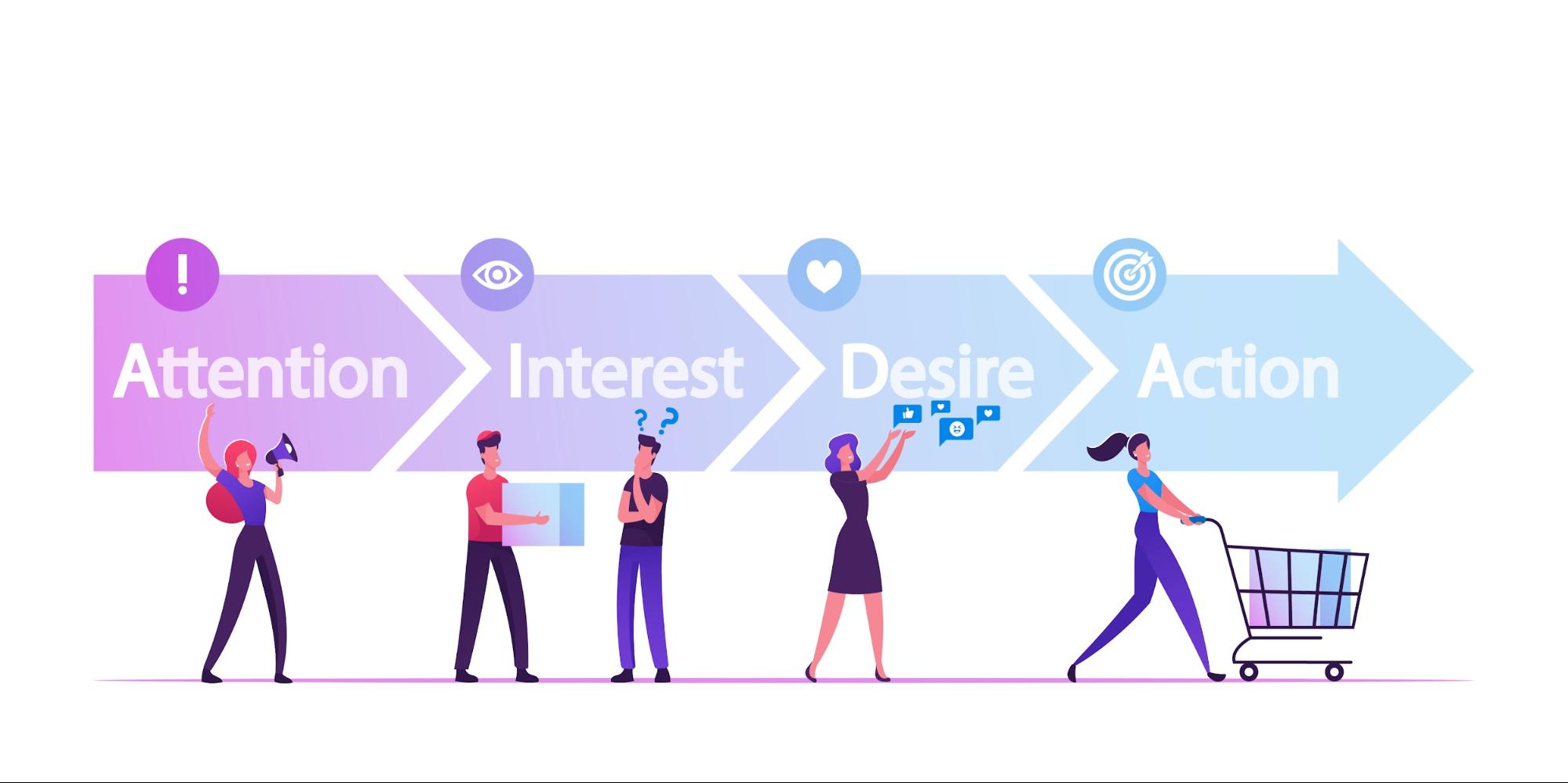
In the first stage, which is drawing attention / raising awareness, we make our first contact with the potential customer. In this stage, where the potential customers become aware of our product or service, we would like to get their attention. Creating brand awareness, we form a connection between them and our product or service.
In the interest stage, the potential customer develops an interest in our product or service and starts researching.
In the desire stage, the potential customer forms an emotional bond with our brand and moves from liking it to wanting it.
In the final stage, which is action, the prospective customer reaches the end of the funnel and becomes our customer by purchasing our product or service.
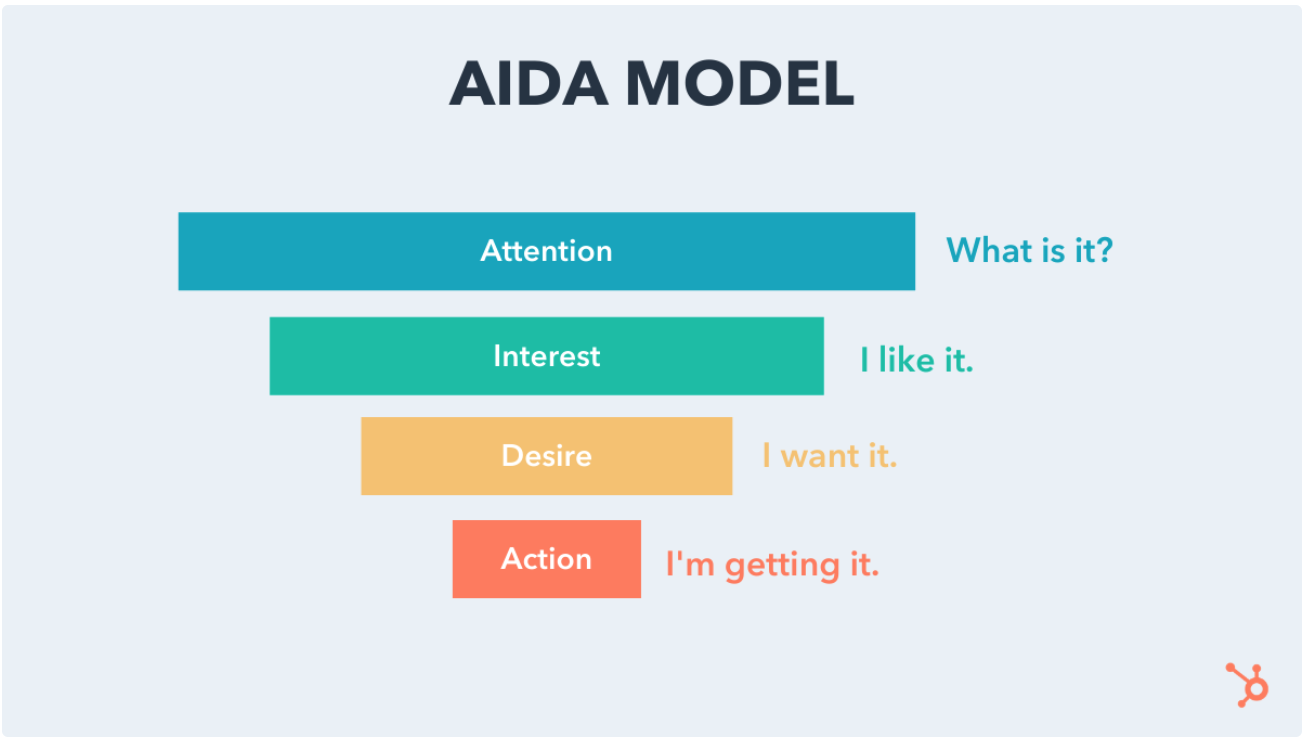 Source of image: Hubspot
Source of image: Hubspot
Although this model taught in Marketing 101 is still valid, the customer journey has undergone some changes with digitalizing. Instead, modern marketing funnels have been created.
2) Modern Marketing Funnels
As the digital world we live in and consumer behavior changed, marketers realized that the marketing funnel did not end with the purchasing step, and eventually the need for new models has arisen. The interaction with the customers was not supposed to come to an end after the purchase had taken place. The funnel needed to be non-linear with stages that constantly improved and which the customers could enter and leave any time. Besides, consumers were reluctant to struggle to understand the brands. They wanted the brands to understand them instead. That's why the traditional model has evolved to the new ones.
With the shift towards digitalization and a more individualistic approach to consumers, many companies created their own marketing funnels. Even though they look different from each other, all new models have emphasized the post-purchase process and aimed to turn customers into loyal customers.
Let me explain a few models:
While other models think of customers as an outcome, Hubspot's Flywheel model thinks about how customers can help your business grow. It never leaves customers in the final stage but turns them into the advocates of your brand.
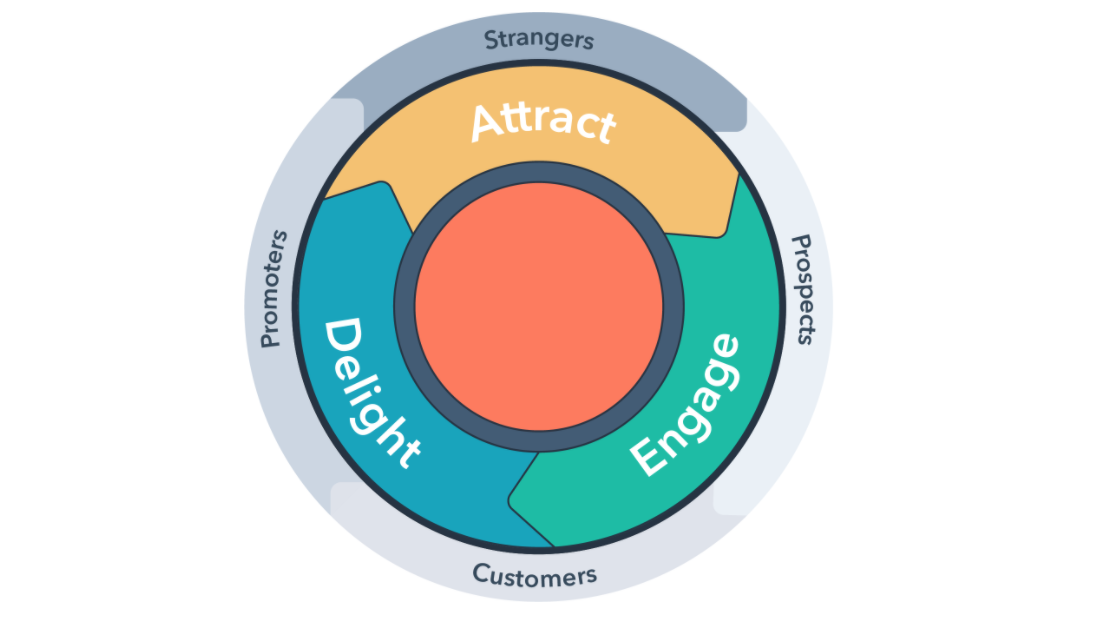 Source of image: Hubspot
Source of image: Hubspot
The model adopted by Moz consists of three stages: TOFU, BOFU, and MOFU. It focuses on retention and the continuity of sales rather than advocacy.
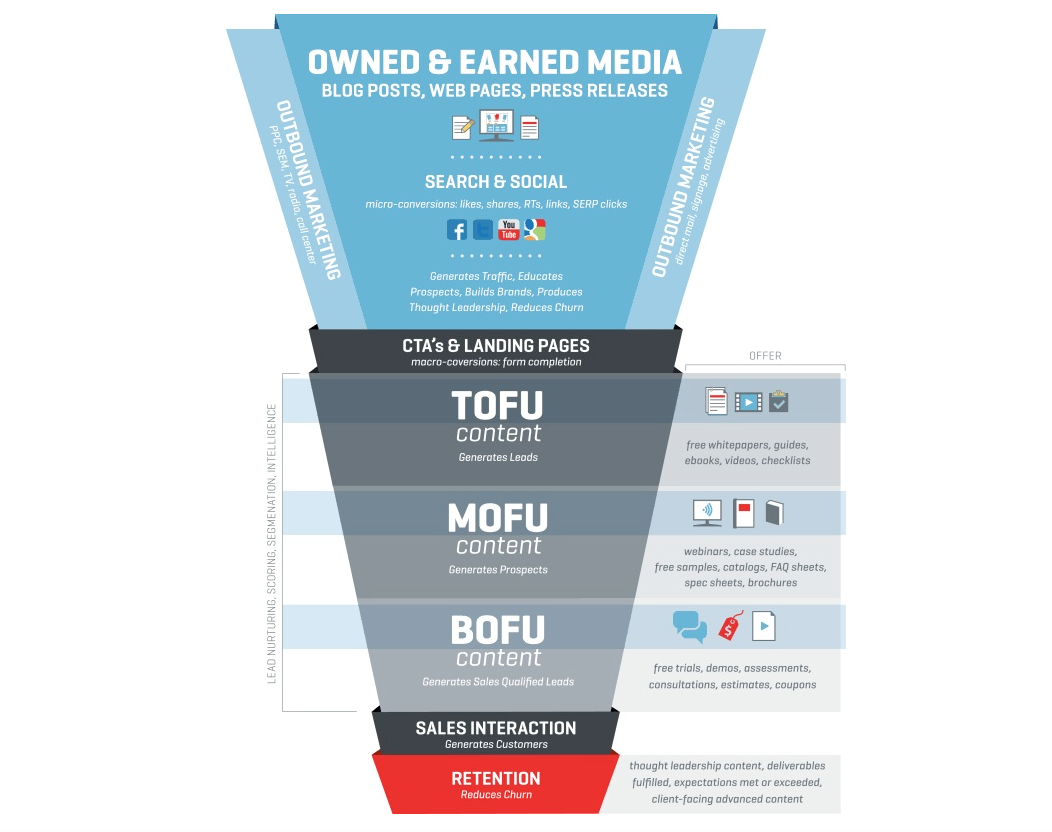 Source of image: Moz
Source of image: Moz
Bizible's Pipeline Marketing Funnel highlights all stages and this model includes terms such as MQL (Marketing Qualified Lead) and SQL (Sales Qualified Lead). MQL refers to the qualified leads who are more likely to become customers than other prospects tracked by the sales team. SQL, on the other hand, refers to the leads who are ready to move into the purchasing phase. In other words, MQLs turn into SQLs when they are ready to talk to the sales team. Focusing on the growth of revenue, this model is optimal for B2B marketing.
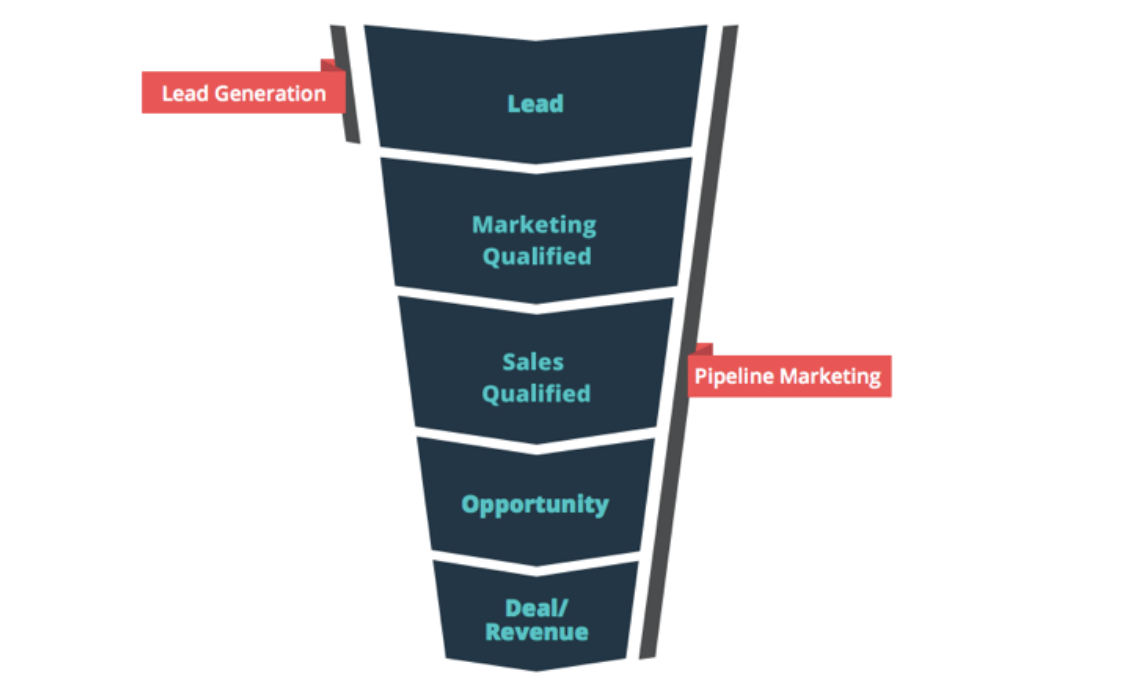 Source of image: Bizible
Source of image: Bizible
The non-linear, lifecycle-based model from Campaign Monitor suggests an omnichannel experience to turn your customers into brand advocates and creates a strategy for lasting brand success. This model allows customers to enter and exit the funnel at any stage.
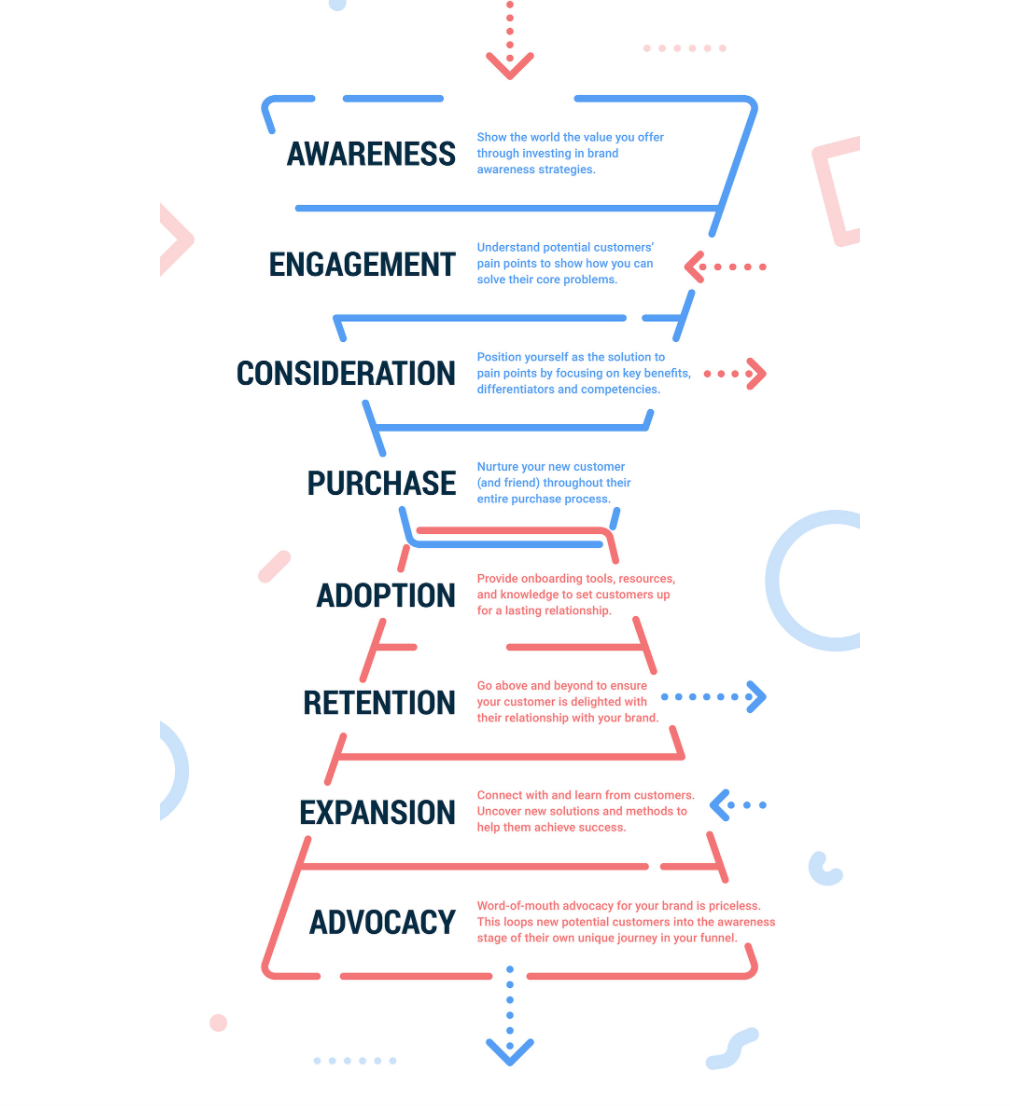 Source of image: Campaign Monitor
Source of image: Campaign Monitor
The new models include more than I have mentioned above and I am sure that many others will emerge as the digital world evolves. What actually matters is to follow the changes and adapt them to our own business types and goals. Every company can have their own unique model while different models can be created for different sectors and segments.
We can develop our own strategies based on one of these models which do not end with the purchasing stage and would make our brand a love mark for our customers who love us and therefore remain loyal to us and then turn them into brand advocates.
Although the new funnels have different definitions and consist of different stages, they all follow a certain strategy pattern. At this point, the question arises as to which marketing activities and content types we will use to structure our marketing strategies by understanding this pattern.
To answer this question, I will start with Moz's model and explain which marketing activities and content types to use in the top, middle, and bottom stages of the funnels. Since some marketing activities help raise brand awareness while some are useful to create a loyal customer profile, I recommend that you take into consideration the stage - marketing activity match I am about to explain while building your strategy.
2.a) TOFU
TOFU refers to the top stages of the funnel; brand awareness, attraction, and interaction.
I will mention which content types to use in order to make the first contact and raise brand awareness. We can produce content on the problems faced by our buyer persona.
Let's think about how our audience can find us. To raise brand awareness, we can use the following marketing activities and content types:
SEO: First, we should build up an effective SEO strategy. We can rank higher by producing SEO-friendly content. In addition to the content strategy, we can also say that technically well-built websites are much easier to be found by the users.
PPC: For our target audience to find us, we can make use of advertisements. These can be Google Ads or social media ads. Apart from these, many other advertising models can be used such as the cost-per-click model for your marketing campaigns.
Content Marketing: It is more efficient to create informative content without the aim of selling a product/service.
Blog: Through keyword research, we can create blog content that meets the needs/requirements of our audience. Checklists and how-to content draw the most attention. We can also use guest blogging for this part of the funnel.
Social Media: We can make sure that our target audience reach us by detecting the social media channels widely used by them. We can be active on social media by sharing posts regularly and using images, videos, and infographic formats.
Infographic: In these days, visual formats are very effective. We can use infographics, which would inform our new users quickly, in our blog posts and social media content.
E- Books: We can make use of downloadable content to draw the attention of our target audience and introduce ourselves. More general topics may be used here. E-books are also effective in accessing the contact information of our target audience.
Webinar: Maybe it is one of the best ways to interact with our target audience on something we are the specialist of. It is another way to access the contact information of our audience.
2.b) MOFU
It refers to the most critical part and the decision stage of the funnel, in which we convert our leads. The content in this stage must be about our business and brand. We should present the most important features of our products or services that would differentiate us from our competitors. We should position our brand in the best way to meet the needs of our customers. I will mention some of the content types here that I did while discussing TOFU, but their use in this stage is for highlighting our products and services rather than inform or educate.
Case Study: Using case studies in this stage will be very useful to maintain reliability. It might be the best proof that we can provide solutions to our SQLs just as we provide solutions to another company's problems.
Blog: It will be helpful to use content marketing, which is also important to improve our SEO performance, in this stage too. However, in this stage, we can focus on how-to content that will highlight our product or service and provide answers instead of producing content to meet the needs of our target audience.
E- Books: We can offer our knowledge and experience by creating e-books with more technical reviews. We can also prepare e-books that explain the features of our products in detail.
Webinar: We can organize webinars that serve as trainings to introduce our products or services. Having a Q&A session with participants will prevent raising question marks in their minds.
E-Mail Newsletters: Through newsletters, we can regularly deliver content that will introduce our products, services, and technical knowledge to our audience, from which we have collected contact information through e-books and webinars and got permission to send e-mails. I recommend avoiding aggressive mailing. By running A/B tests, we can choose the optimal days and hours for our audience, when our open rate and click rate are the highest.
Retargeting Ads: We can retarget the users who have visited our site and remind them of ourselves. For that, we can use tools such as Facebook Audience, Adroll, and Criteo.
2.c) BOFU
We attracted our leads through TOFU contents and earned their trust through MOFU contents. Now, it's time for the purchase and the post-purchase stage. This stage is also important to build customer loyalty.
Content types we can offer to our target audience that’s ready to buy:
Coupons / Special Offers: Especially if we have an e-commerce site, this method can help us give them a buying motive. We can strength our bond with the our audience through special offers.
Product Demos: Showing how our products exactly work is a critical step towards the decision to buy them. In a video format or live, we can highlight the distinctive features of our products that will take us one step ahead of our competitors. We can also prepare video series to explain our products in detail. Offering free trials for our products will help speed up the conversion period.
Customer Reviews and Case Study: Customer stories and reviews are persuasive factors in the final stage. We can use both video or written format. We can also ask our customers to review us on various platforms.
Customer Services and Help Resources: Help resources and forming a frequently asked questions part will enable the person in the purchasing stage to find answers to his questions and take action. Using a pricing page that offers various options will also affect your conversion rate positively. It will be useful to provide the contact information of customer services for special pricing plans and possible questions. You can read this successful case study on how to optimize a pricing page.
E-Mail Automation: Through e-mail automations, we can send follow-up e-mails to our audience with which we have had sales meetings. We can increase our conversion rates through these e-mail content. We should maintain our interaction with the customers in the post-purchase process to ensure their loyalty, during which we can ask them to review the purchased product or service.
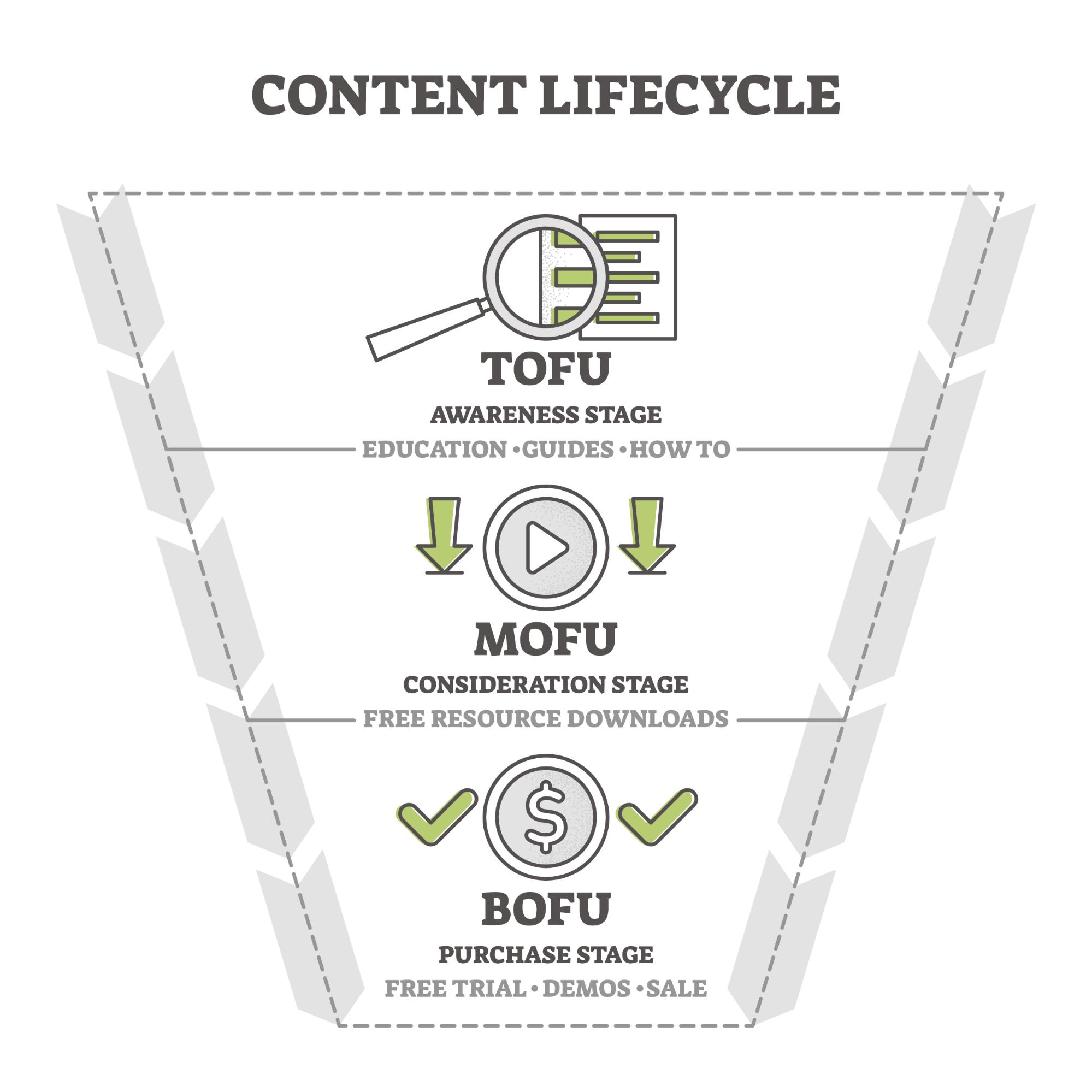
3) Developing Strategies Through OKR - Bonus: Template
Developing a marketing funnel helps us visualize our strategies and create an effective campaign.
After deciding which part of the funnel to refer to in line with our marketing goals, we can create the appropriate content as I have mentioned above. In this way, we can develop a more controlled and effective strategy to provide our target audience with the content they need.
First, we must set our goals to build up our strategy. To do so, we can use the OKR (Objectives & Key Results) method. This method called Objectives and Key Results is a targeting methodology that enables companies to set their goals and work in cooperation to achieve these goals.
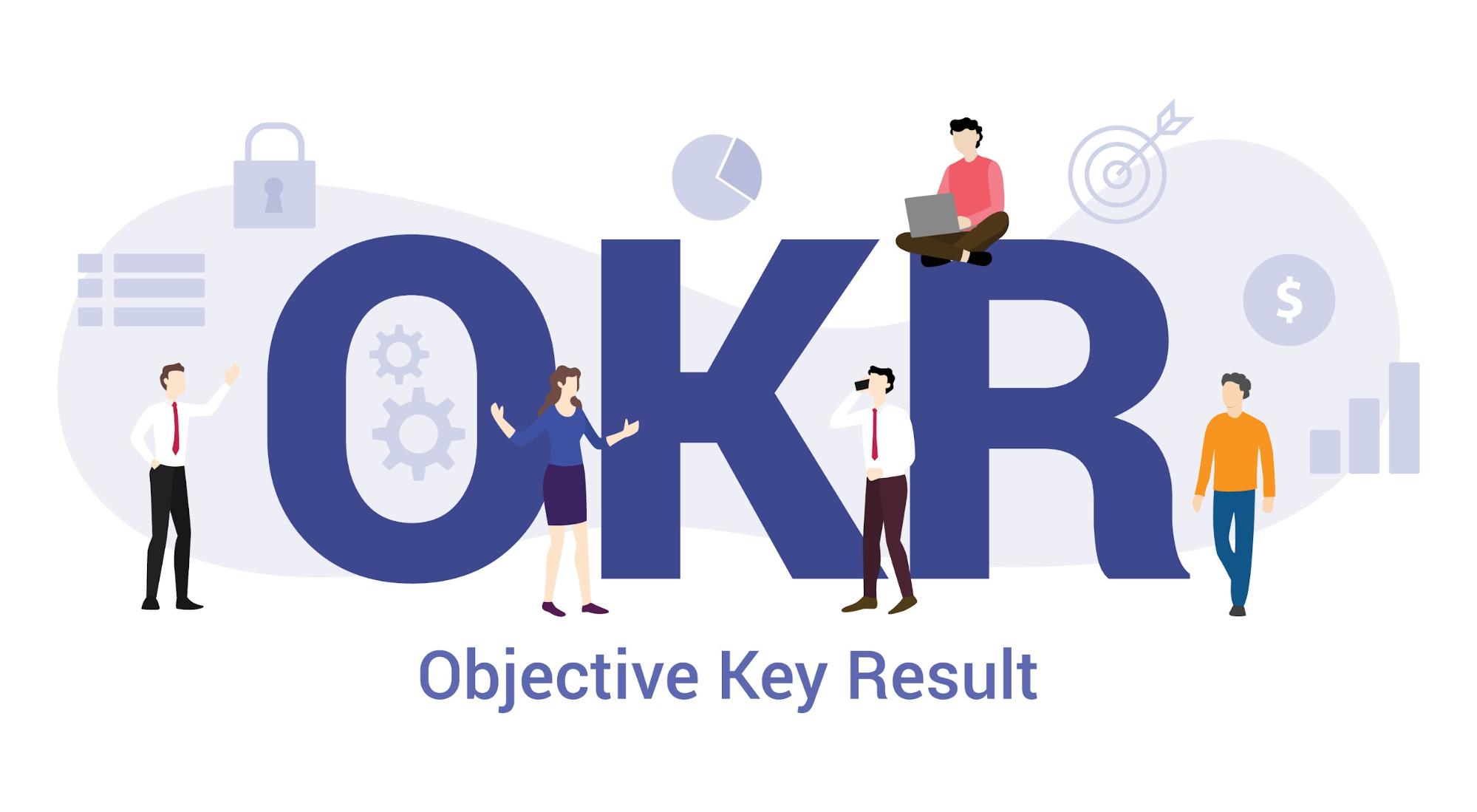
OKR does not date back to very early times and is associated with Andrew Grove who was the CEO at Intel. Used by Larry Kim from Google, this method became popular among many tech companies such as LinkedIn, Uber, and Microsoft.
Through the Objectives and Key Results method, we can focus on our priorities and enable our team to achieve its goals in harmony. In addition to being a good way for us to tell if the teams are contributing to each other by setting shared goals, it helps measure the goals accurately.
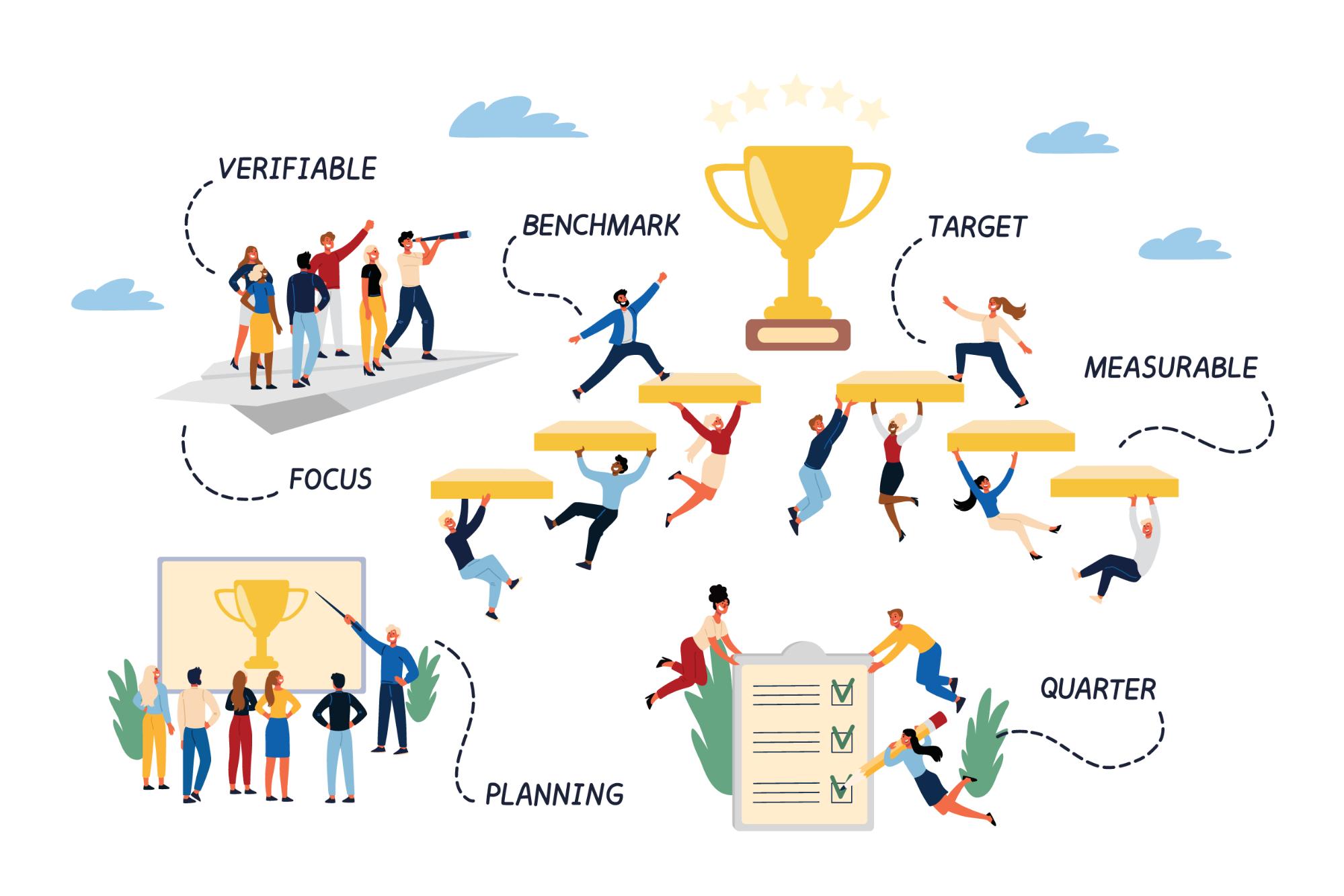
We can create annual or personal OKRs. Dividing our annual goals into quarters will be really effective.
First, we need to set our objectives. These should include our primary and biggest objectives. It is usually recommended that we set three or five company objectives. We should set fair, qualitative, and applicable objectives.
Then we will be ready to set our key results. These can be considered benchmarks that we will track on the path to our objectives. We can define them as little actions that will take us to our objectives.
Of course, it may vary for each case but we can set 3-4 key results per objective. For instance; each department of a company can be asked to set a key result to achieve the common objective or each member of the marketing department can aim for a different key result to achieve the common objective.
Key results should be specific, applicable, and measurable. Primary results may be based on growth, performance, revenue, or interaction. For instance, a key result may be X% growing sales or increasing the number of visitors from X to Y.
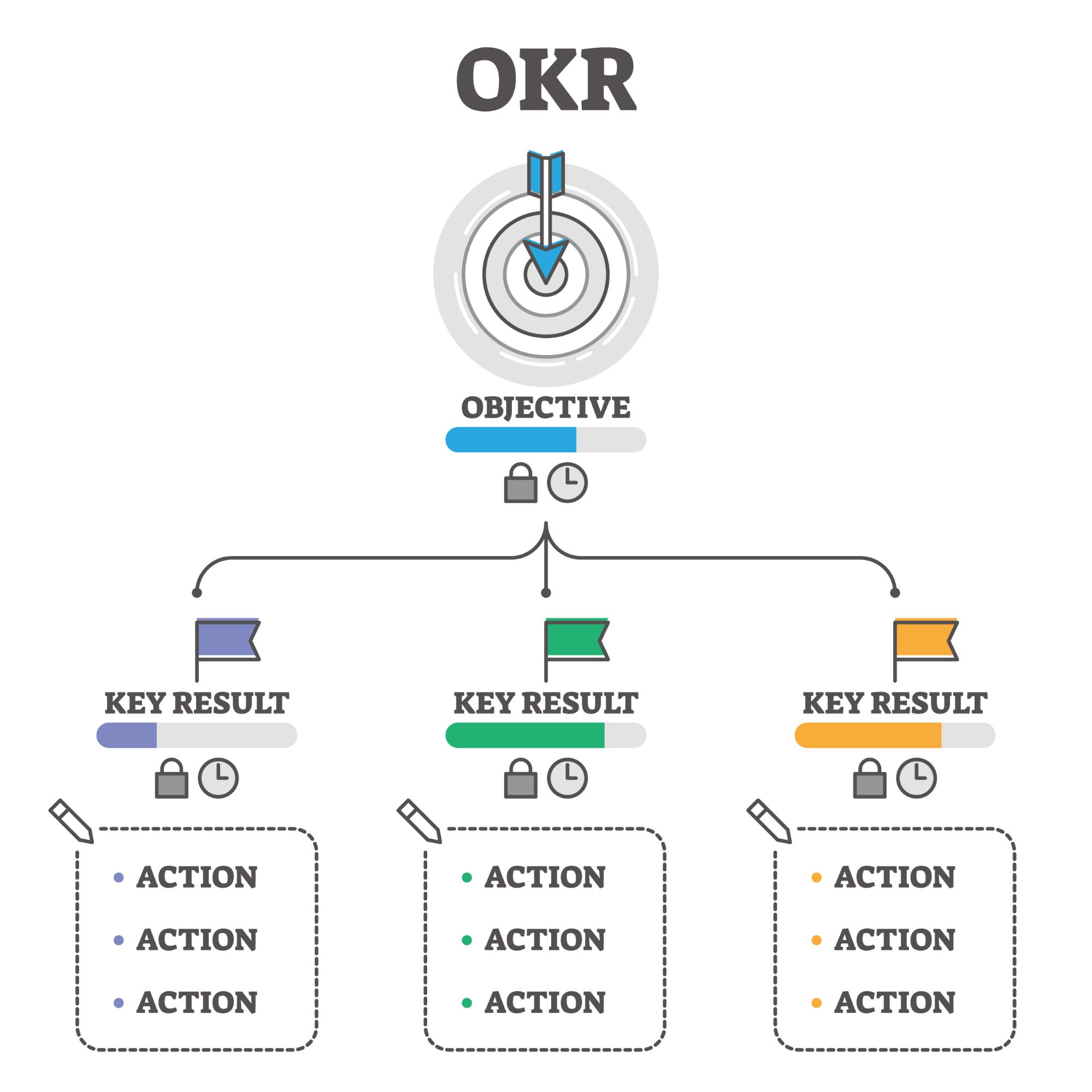
Then, we should track our OKRs regularly and evaluate them at the end of each quarter. During this evaluation, we should score how much of our objectives and key results have been realized.
Let me give an OKR example to make it clearer.
Objective: Raise brand awareness (10/10)
KR1: Increase the number of visitors to the website by 40% through SEO work and blog posts. (4/10)
KR2: Increase the webinar participation rate from 10% to 20% (3/10)
KR3: Convert 30% more with 100$ budget for ads by the end of the quarter. (2/10)
KR4: Have 2.000 followers on social media (1/10)
After setting our OKRs, we can decide which stages of the funnel they correspond to. The example above corresponds to the TOFU stage so we should work on the content accordingly.
Of course, it is very important to set our target audience in accordance with our brand and business objectives. We should understand our target audience and meet their needs through suitable marketing activities.
Finally, you can click the link below to see the template I prepared: On the first sheet of this annual template, you can set your OKRs.
After setting your marketing objectives, you can set a KR to achieve in every quarter. Score your process at the end of each quarter to see how much of your objectives you have achieved. You can convert this template to a quarter objective-key result schema. You can assign 3-4 key results to achieve in each quarter.

After setting your OKRs, you can set your target audience and decide which stages of the funnel your objectives correspond to. For example, you can mark awareness if you are releasing a new product, or loyalty and advocacy for a product to maintain its position in the market.
On the second sheet where you can see the details, you can mark the stages of the funnel to which your objectives correspond and see the list of materials / content types that you can use in these stages. You can both mark which content to use or not in line with your objectives and take notes to clarify how you can use them. Besides, you can use it as a benchmark to compare with your table from the previous year.
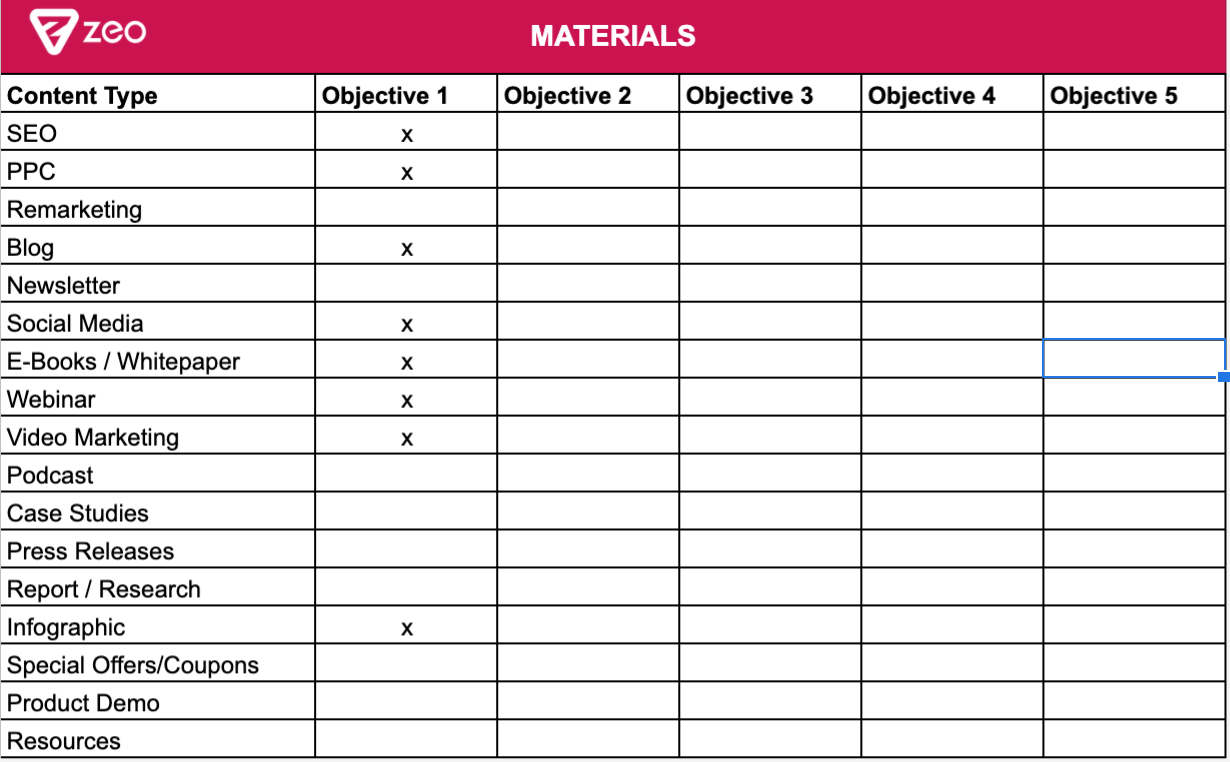
Since objective 1 in the example corresponds to the TOFU stage, I marked the content types that can be used in this stage. You can also write the details of contents such as "start working on Google Ads" for PPC.
The Template Link: http://bit.ly/template-build-your-annual-marketing-strategy
So, we have got to know the marketing funnel within its historical development and realized that new and more effective models have emerged with digitalization. We have covered the content that can be used in TOFU, MOFU, and BOFU stages and decided on the suitable content types for each stage.
After setting our objectives through the OKR method, we have decided which stages of the funnel they correspond to, and developed our marketing strategy by creating content suitable for these stages.
You can create your marketing strategy more quickly by using the template. Please do not hesitate to ask your questions in the comments section!
Resources:
https://www.smartinsights.com/traffic-building-strategy/offer-and-message-development/aida-model/
https://www.singlegrain.com/blog-posts/content-marketing/how-to-create-marketing-funnel/
https://www.lucidchart.com/blog/what-is-tofu-mofu-bofu
https://blog.denamico.com/heres-the-difference-between-tofu-mofu-and-bofu-offers
https://weekdone.com/resources/objectives-key-results
This article was written by our former Marketing Specialist Gökçe Yeşilbaş.
















